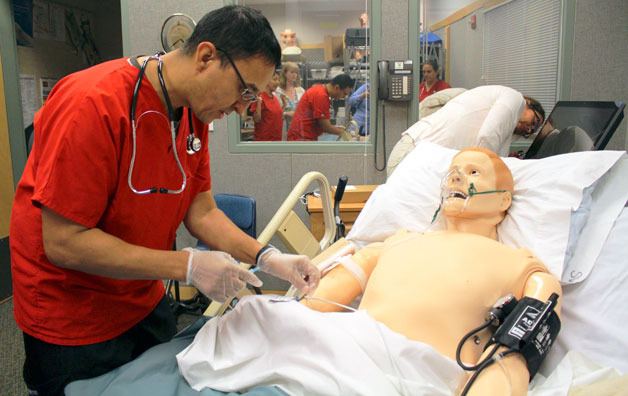Yesenia Leon’s patient can sweat, bleed, breathe and run a fever — but he can’t die.
The nursing student was one of the first at Skagit Valley College to try out a state-of-the-art simulation manikin last week.
Someone who wants to remain anonymous donated $180,000 to the college toward purchasing two of the manikins, called SimMan 3G, which allow students to practice real-life situations they’ll face on the job in a controlled setting.
“If we mess up, we’re not risking someone’s life,” said Leon, who graduated last weekend from the practical nursing program.
The manufacturer, Laerdal, said the manikins are designed to train military and civilian emergency medical personnel in trauma situations such as hemorrhage control.
The manikin reacts like a real patient in a variety of scenarios: he can stop breathing and turn blue, sweat can bead on his forehead, his eyes can dilate, blood can gush from wounds and his tongue can swell. The manikins react to treatment, including medication. Even the sex of the manikin can change — “he” can be a “she” so students can practice, for instance, putting in a catheter. That’s just the tip of the iceberg on what the manikins can do.

Skagit Valley College previously used less sophisticated dummies in the classroom. The new manikins are far more lifelike, allowing students to react to subtle changes rather than a scenario they know is coming.
The SimMan is so advanced, the state legislature updated the state administrative code that governs licensure for nurses to allow them to replace up to 50 percent of their internship clinical requirements needed for a state license with time on the SimMan.
Skagit Valley still plans to keep the clinical requirements for its students the same, said instructor and registered nurse Kathleen Pendleton. The manikins come with countless simulation activities so nursing students can react to scenarios they may not have seen during their clinical internships.
That’s especially important in a rural setting such as Whidbey Island, where nursing students compete for limited clinical opportunities to hone skills with real patients, said Jan Helm, department chair of the Whidbey campus’s nursing program. They may not encounter all the scenarios they would at larger urban settings.
It’s not just working with the manikins but later reviewing what the students did that’s valuable, she said. Computer software with the manikins track every intervention by the students.
“We are incredibly grateful someone donated these,” Pendleton said.
The Whidbey campus received one of the manikins and the Mount Vernon campus received the other. Instructors attended training sessions and they’re just getting the manikins ready to fully integrate into the classroom this fall.
The donation came in the nick of time, just as the service licenses on the old simulation manikins were expiring.
“It’s not ‘real’ real but it’s helpful,” said Khalil Qul, who just completed a practical nursing certificate. “You can make a mistake and come back and see what went wrong.”

